Everything you need to know about ampelous strawberries and strawberries
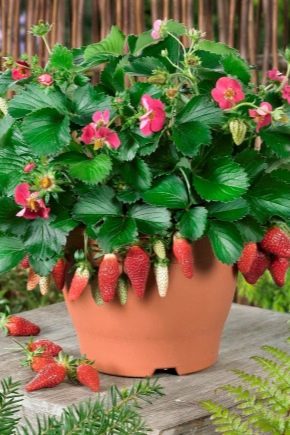
Given the unique properties, many are now trying to find out everything they need to know about ampelous strawberries, which are a kind of common strawberries. This is one of the species obtained by breeding. The main feature and advantage is the combination of the practical benefits of culture and aesthetics. Abundantly and long-term fruiting weaving ampelous varieties become a real decoration. They can be seen in the form of alpine slides in gardens and small courtyards, as well as in various pots that are elements of interiors.

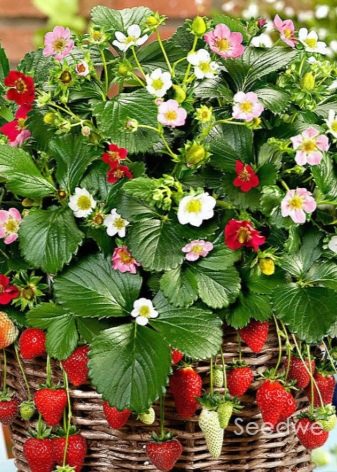
Peculiarities
The description of ampelous varieties should start with the fact that their main feature is the formation of fruits. In curly strawberries, berries are present not only on the stems, but also on the whiskers. By the way, it is worth noting that in the literal sense of the word, it is not a cascade. In the overwhelming majority of cases, remontant species are chosen for planting, a distinctive feature of which is a large number of whiskers, as well as outlets that are capable of releasing their shoots with peduncles without contacting the ground.
To evaluate all the features of the described plants, it is worth highlighting their key advantages.
-
the ability to fully develop, bloom and bear fruit with a lack of sunlight;
-
long-term fruiting;
-
outstanding taste;
-
high productivity;
-
the ability to form any compositions, including on vertical flower beds.
By cons include frequent transplanting and high requirements for the quality of the substrate, including moisture.
In addition to the outstanding taste of the fruit, climbing ampelous strawberries are capable of striking with their aesthetic qualities. We are talking about cascades of shoots, first decorated with white flowers and then with berries. It is important to note that breeders have bred varietal varieties of climbing strawberries with pink flowers that are unique in terms of decorativeness.
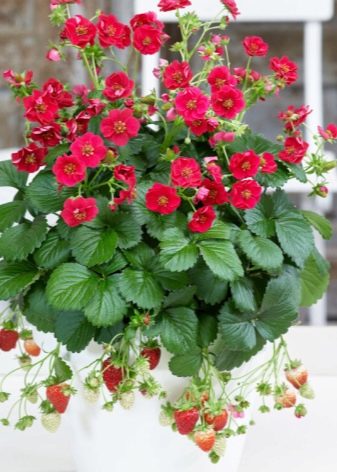
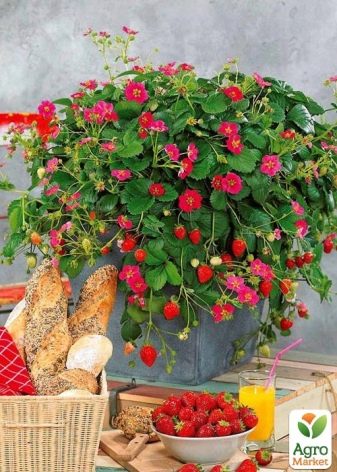
Varieties
- Taste: spicy
- The size: large
- Weight: 30 g
- Repairability: Yes
- disadvantages: sensitive to waterlogging
- Appointment: fresh consumption, processing (juice, jam, jam, etc.)
- Repairability: Yes
- Berry color: Red
- Amplitude: Yes
- Berry shape: elongated
- Scent: pronounced
- Transportability: Yes
- Taste: sweet
- The size: large or medium
- Weight: 30 g
- Yield rate: high
- Yield: 1.5 kg per bush
- Repairability: Yes
- Taste: melting sugar, velvety, with sourness
- The size: large
- Weight: 60-90 gr
- Yield rate: high
- Yield: 0.9 kg per bush
- Repairability: No
- Taste: sweet
- The size: large
- Weight: 30-50 gr
- Yield: 2.5 kg per bush
- Repairability: Yes
- Appointment: universal
- Taste: super sweet
- The size: large
- Weight: 30-40 gr
- Yield rate: high
- Yield: up to 1 kg per bush
- Repairability: Yes
- Taste: sweet
- The size: large
- Weight: 25-30 gr
- Repairability: Yes
- Ripening terms: early
- Description of the bush: compact
- Taste: sweet and sour
- The size: large
- Weight: 30-60 gr
- Yield rate: high
- Yield: more than 1 kg per bush
- Repairability: Yes
- Taste: sweet
- The size: large
- Weight: more than 50 gr
- Yield rate: high
- Yield: 1.2-1.5 kg per bush
- Ripening terms: mid-late
- Taste: sweet
- The size: average
- Weight: 35 g
- Yield: 1 kg per bush
- Repairability: Yes
- Description of the bush: short, squat
- Taste: sweet
- The size: average
- Yield rate: high
- Repairability: Yes
- Ripening terms: early
- Appointment: fresh consumption, processing (juice, jam, jam, etc.)
Landing
Despite the fact that ampelous species are characterized by frost resistance, they are quite sensitive to return frosts. That is why disembarkation should be performed only at a stable positive temperature. The varieties in question can be grown in ordinary beds, but more often these bushes can be seen in a more exotic form:
-
in a pots;
-
in bags;
-
in boxes installed on vertical racks;
-
in flowerpots;
-
on vertical flower beds (columnar structure);
-
on the alpine slides;
-
in pipes installed vertically.
Practice has proven that the described varieties of strawberries look spectacular in pots: floor and hanging. With this method of planting, it is important to consider the following points.
-
The size of the pot should match the potential size of the bush.
-
A drainage layer is required.
-
The soil should be as nutritious as possible and have high drainage properties.
-
The planting process is standard.
-
It is imperative that after planting it is required to water the seedling, and place the pot in a well-lit, but at the same time reliably protected from drafts, place.
Care
Naturally, it will not be enough just to plant the described strawberry varieties correctly. Only competent care will allow achieving results in the context of fruiting and aesthetics. For example, special attention should be paid to how to preserve plants in winter. However, it is worth noting that it is quite simple to grow ampelous strawberries, including manipulations aimed at preparing it for wintering in the fall.
Novice gardeners who will take care of such plants for the first time will not have to deal with anything unusual. All procedures provided by agricultural technology are standard:
-
watering;
-
fertilization;
-
pruning.
In addition to all of the above, loosening of the beds and weeding should be mandatory. Experienced gardeners also recommend mulching the soil and growing young strawberries under a film.
Watering and feeding
Irrigation of ampelous strawberries should be moderate with constant monitoring of the state of the soil. These plants react equally negatively to both drought and excess moisture. In the first case, we will talk about a decrease in yields, and in the second, about the risk of developing diseases.
It is important to remember that bushes grown in hanging containers are watered exclusively through pallets. This allows you to provide the necessary amount of moisture for plants and avoid stagnation in the soil. In the beds and often in the garden, drip irrigation systems are successfully used.
As dressing organic and mineral complexes will be required. It is worth noting that the first option is more relevant for strawberries growing in the open field. If we are talking about bushes cultivated indoors, then it is better to use ready-made special mixtures. At the initial stage of plant growth, nitrogen-containing fertilizing will be required, and from the flowering stage, phosphorus and potassium supplements will be required.
Pruning
In this case, it is important to highlight the following key stages of work performance.
-
Removing the first peduncles. This will significantly increase the yield.
-
Getting rid of the lower leaves. This should be done immediately after the first harvest is fully ripe.
-
Mustache trimming.Since excess shoots will take up nutrients and slow down the formation of ovaries, no more than 5 whiskers are left.
It is worth noting that the number of shoots required is determined individually in each specific case, taking into account the varietal characteristics and conditions of detention.
Reproduction
Initially, it is important to note that many new varieties are mustacheless. Breeding plants by division is associated with certain difficulties. Based on all of the above, Many gardeners consider the best option to propagate small-fruited varieties of ampelous strawberries by seeds, and large-fruited species by seedlings grown in nurseries.
If we are talking about rooting outlets, then it should be borne in mind that several new units can be obtained from one bush for the next season. To do this, you will need to leave no more than 5 whiskers on the mother bush for fruiting in the first year. All the rest will need to be planted in small pots located nearby. Containers with the material are placed for 10-12 days in partial shade. It is important to remove peduncles on young growth.
The algorithm of actions for propagation by seeds is as follows.
-
Preparation of a light substrate.
-
Distribution of seeds over the surface (deepening taking into account the size is not required).
-
Covering sowing with foil or glass.
-
Placing a greenhouse in a warm (+25 degrees) place. It is important to air the planting daily.
-
Transfer the greenhouse to a well-lit place after germination (1-3 weeks) of the seedlings.
-
Removing the hiding place when 2 true leaves appear. Watering is carried out with a pipette or syringe.
-
Picking seedlings at the stage of formation of 2-3 leaves. The temperature at this stage should be 15-16 degrees.
-
Planting in a permanent place when 5-6 leaves appear.
Summing up, it is worth noting that cultivation of strawberries with a mustache is accompanied by the risk of viral diseases.
Diseases and pests
Due to the fact that the ampelous varieties have minimal contact with the soil in the beds, that is, open ground, they are less likely to suffer from diseases and pest attacks. However, this does not mean that the risk is completely absent, and gardeners who grow beautiful columnar compositions sometimes have to face the following problems.
-
Late blight, leading to drying out of leaf plates and damage to the roots. For preventive purposes, Bordeaux liquid is successfully used.
-
Powdery mildew the main symptom of which will be a characteristic bloom on the fruits. As in the previous case, the treatment with the specified means is effective.
-
Gray rot. The development of this fungus is the result of excessive moisture and is manifested by brown specks on the leaves. Having found the latter, it is necessary to treat the bushes with preparations containing copper.
If we talk about attacks of harmful insects, then strawberry mites and weevils, as well as nematodes, are most often parasitized on ampel varieties. Traditionally, the most effective means of control will be the treatment of plants with insecticides.

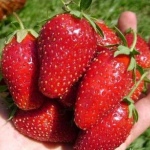
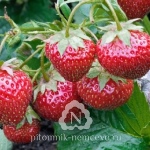
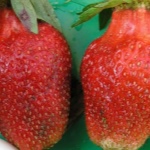
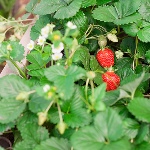
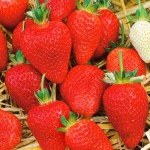

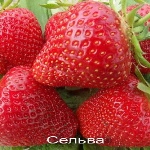
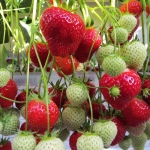
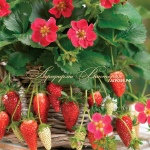
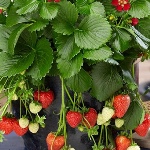


















The comment was sent successfully.